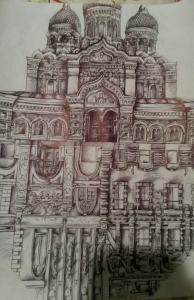Art has been with me since childhood. Some of my earliest memories involve me sitting at the kitchen table with a fistful of crayons, or glancing at my grandmother’s watercolor sketches–she was an amateur artist herself. In elementary school, I drew all over my assignments instead of actually completing them, and claimed I wanted to be an artist when I grew up. While since then all that has changed, my love for art has not. That said, I confess I know next to nothing about Celtic art or Celtic artists, and decided to rectify that by doing a bit of research and writing a blog post on my findings.
When I say ‘Celtic art’, I’m not talking about the traditional, iconic high-crosses of Ireland, or even the intricate scabbards and torcs done in the La Tène style; rather, I’m referring to painters and sculptors from the last couple of centuries who can, at the very least, trace their ancestries to the Celtic fringe. Evidently, there are many such artists, and more than I could ever hope to detail in a blog post; so I’ve chosen only a few to share.

Celtic High Cross
There is first the Irish painter Sean O’Sullivan, who was born in Dublin in 1906 and died in 1964. Glancing through O’Sullivan’s work, it is clear he is primarily a portrait painter, with a tendency towards bright colors and simplistic, slightly cartoonish renderings of reality. Yet sometimes his pieces are no more than sketches, cross hatches and smudges, really, which work together to create brief impressions of his subjects. Some of O’Sullivan’s portraits include those of Douglas Hyde, W. B. Yeats, and James Joyce.
Alfred Janes was a Welsh artist, born in 1911, and, like O’Sullivan, he was interested in portraits, painting pictures of Dylan Thomas and other close friends. That said, he did not confine himself to one style, and, especially later in his life, also experimented with abstract art. His portraits appear a bit cartoonish, but are still stylistically different from O’Sullivan’s; his people possess strong, sturdy bodies, thick forearms, and wide eyes gone dark and sharp with intensity. Janes favors dark, muted colors, although his pieces have occasional bright sparks, such as the yellow tie in his portrait of Dylan Thomas, or the yellow-white pricks of light on the apples in ‘Boy with Apples’. This type of palette, while established in his early paintings, bleeds over into his abstract pieces as well.

Portrait of Dylan Thomas
William Crosbie, the third and final artist I will discuss, was born to Scottish parents in China, although his family returned to Scotland in 1926. Artistically, his style is even more varied than Janes’, and his subjects range from still-lifes, to landscapes, to portraits, to abstract pieces. His abstract pieces suggest Picasso as an influence (see ‘Playing to my Friends’, a more tame example of this), although he was evidently capable of realism as well. Many of his pieces make use of vibrant colors, although some are done completely in black and white. In sum, it is difficult to attribute one style to Crosbie.

Self Portrait
I can’t say this brief bit of research has allowed me much insight into modern Celtic art–but I did note that, stylistically, these three artists are making use of techniques employed by other, non-Celtic artists as well. There is nothing that unites or sets them apart, nothing that screams ‘Celtic!’ besides, occasionally, the subject-matter. In the context of the poetry we have been reading, this is especially interesting, considering many of the poems are heavily influenced by Celtic culture and a sense of nationalism, and display these sentiments overtly in language (for example, the use of Celtic words, or the invocation of Celtic myths). The apparent neutrality of these artists presents a striking contrast to this. That said, it is entirely possible O’Sullivan, Janes, and Crosbie felt the influence of their respective Celtic ancestries and are actually conveying this in their artwork; I just might not be learned enough to pick up on these influences.
And just for fun, I’ve included a couple of my own pieces 🙂
Websites used:
1. “Kooywood Gallery, Museum Place, Cardiff.” Oriel Kooywood Gallery. N.p., n.d. Web. 18 Mar. 2017. <www.kooywoodgallery.com/display.php?aid=249>.
2. “BBC – Wales – Arts – Alfred Janes.” BBC News. BBC, n.d. Web. 18 Mar. 2017. <www.bbc.co.uk/wales/arts/sites/alfred-janes/>.
3. “Sean O’Sullivan (Irish, 1906 – 1964).” Mutual Art. ARTFIXdaily, 20 July 2016. Web. 18 Mar. 2017. <www.mutualart.com/Artist/Sean-O-Sullivan/695468CEEDE08090>.
4. “William Crosbie.” The Scottish Gallery, n.d. Web. <www.scottish-gallery.co.uk/artist/william_crosbie>.
5. “Seán O’Sullivan (painter).” Wikipedia. Wikimedia Foundation, 12 Mar. 2017. Web. 18 Mar. 2017. <en.wikipedia.org/wiki/Se%C3%A1n_O%27Sullivan_(painter)>.







W.B. Yeats had a brother, Jack, who was a painter. Here’s a link to some of his work:
www.tate.org.uk/art/artists/jack-butler-yeats-2178